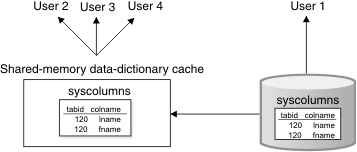Data-dictionary cache
The first time that the database server accesses a table, it retrieves the information that it needs about the table (such as the column names and data types) from the system catalog tables on disk. After the database server has accessed the table, it places that information in the data-dictionary cache in shared memory.

The database server still places pages for system catalog tables in the buffer pool, as it does all other data and index pages. However, the data-dictionary cache offers an additional performance advantage, because the data-dictionary information is organized in a more efficient format and organized to allow fast retrieval.